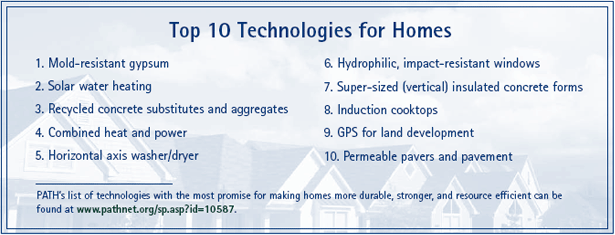February 2008
In this Issue
A National Crisis with Global Impact
Secondary Mortgage Markets: Increasing Capital and Improving Housing Affordability
Waiting for Technology: A Research Agenda
Which Type of House Would You Buy?
In the next issue of ResearchWorks
Waiting for Technology: A Research Agenda
Technology has made living spaces increasingly comfortable, energy-efficient, affordable, and easy to build — but even greater advances are within reach. Recent technological advances that will improve the quality of most new and existing homes await widespread acceptance.
One such technology is the tankless water heater, which has an electric, gas, or propane heating mechanism activated by the flow of water. Unlike heaters that store warmed water in storage tanks (which typically lose enough energy to account for 20 percent of the average household energy budget), tankless models heat water on demand. Although the initial cost of a tankless heater ranges from $500 to $900, this outlay is more than offset by reduced energy costs over time.
Field-tested and ready for widespread use, tankless water heaters are not commonly found in homes, despite potential savings in water, energy, and floor space. According to HUD’s Partnership for Advancing Technology in Housing (PATH), several reasons account for this. First, builders and consumers are unaware of the advantages of tankless heaters. Second, most plumbers and electricians are not trained to specify and install these heaters. Furthermore, many local officials cannot interpret the installation of the temperature and pressure valve. Finally, the heaters are not uniformly available throughout the United States. As a result, the technology cannot be widely used until comprehensive information about the heaters has been disseminated, training sessions held, and interfaces made with existing systems and procedures — all of which takes time.
Reducing the Wait
The example of tankless water heaters demonstrates the obstacles currently hindering the adoption of new housing technologies. It generally takes 10 to 25 years for an innovative technology to spread throughout the residential construction industry, if not longer. To address this issue, a symposium of housing industry, government, and academic experts met in February 2006 in Washington, DC, to pinpoint and plan to eliminate obstacles that slow the diffusion of new housing technologies into American homes.
Among the most significant barriers to the spread of new housing technologies are risk aversion, tradition, poor information flow, and industry fragmentation. Builders prefer to stay with products, applications, and processes known to be reliable so as to avoid the risk of added costs and time-consuming litigation. Consumers and others favor the familiar over the unknown. Information and training on innovative techniques and practices fails to reach all industry players. The homebuilding industry is not tightly organized or coordinated; its participants often work independently.
The symposium participants agreed that accelerating the adoption of new housing technology will require a thorough understanding of research and development, as well as market adoption processes. Researchers must also understand the housing industry, its influences, and the typical ways that manufacturers, builders, consumers, and others contribute to home technology decisions. The group set critical research objectives for the next five years that will require public-private collaboration to advance the transfer of innovative housing technologies. The prescribed research agenda would produce much-needed information about the following:
-
Industry performance and market segmentation;
-
Product and process performance;
-
Effects of new technologies on housing performance;
-
Acquisition and transfer of knowledge about innovation;
-
Ways in which distributors, suppliers, retailers, real estate agents, appraisers, and media drive innovation;
-
Methods for standardizing data collection and analysis across the industry;
-
Influence of perceptions, motives, and behavior of consumers, builders, and manufacturers on the diffusion and adoption of innovations in housing; and
-
Technology application successes and failures experienced by homebuilding product manufacturers.
This research agenda promises better information that will lower the risk for all who have a stake in the quality of housing, economic growth, and improved standards of living. It offers opportunities for industry players to maintain a competitive edge, for the private sector to take part in collaborative research, and for the public sector to participate where it is needed most in facilitating the diffusion of innovative housing technologies.
Symposium recommendations and details are reported in Residential Market Research for Innovation: 2006 Technical Report. Prepared in cooperation with McGraw Hill Construction, the report is available for download at www.huduser.gov/publications/destech/Res_mrkt.html or in print from HUD USER for a small fee by calling 800.245.2691, option 1. Read about PATH’s list of technologies for concerted transfer or diffusion efforts at www.toolbase.org/PDF/CaseStudies/toptentechnologies.pdf.


